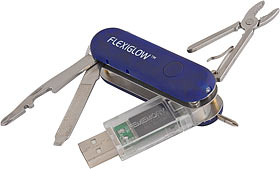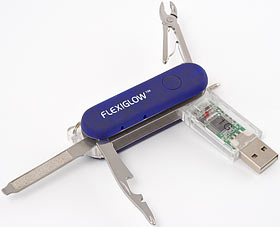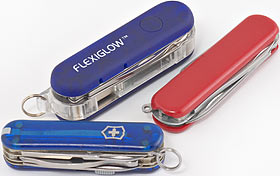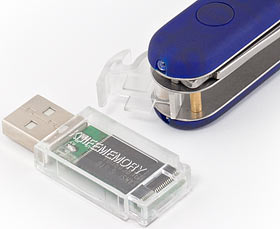
Flexiglow Multi Tool Flash Drive
Review date: 13 September 2006 Last modified 03-Dec-2011.
Do you carry a pocketknife?
(You should, of course.)
Do you also carry a USB flash drive?
Well, amalgamating the two seems like quite a good idea, doesn't it?
The main obstacle to miniaturization of "thumb drives", you see, is that if you make them as small as they can be, people will find it hard to hold onto them. As the smaller memory card formats make obvious, even a stripped-down shell-less USB plug is a lot bigger than any other part of a high capacity Flash memory device needs to be.
So you can incorporate a USB drive into a little pocketknife quite easily. Just make a stubby little drive and build it into the knife, just like any other fold-out tool.
Victorinox, the more famous of the two companies that make "Swiss Army" knives (actually, they own the other one now), were the first people to make multi-tools with USB drives in 'em.
They started with a variety of "SwissMemory" knives, then moved on to the undercapitalised "s.beat" MP3 player, which is tool, USB key and MP3 player combination.
Whether this is much of a step forward is questionable, since the s.beat gives you the chance to pay the price of the new four gigabyte iPod Nano for a fairly underwhelming one gigabyte player (which apparently can't actually quite play all of the formats it's meant to be able to), plus the same tools you get on a $19 knife.
Except no toothpick or tweezers.
The electronics modules of the s.beat and SwissMemory knives are removable, mainly so that you can keep the electronics with you if you go somewhere where very sensible people say pointy things aren't allowed. Another possible approach to this problem, though, is to make a "knife" that doesn't actually have any blades - just other kinds of tools. And some USB memory. And a toothpick and tweezers, or at least some extra things in the sides of the device, so the customer doesn't feel ripped off.
Oh, and a lower price tag. That'd help with reduce the ripped-off feeling, too.
Tah-daah.
This is Flexiglow's Multi Tool Flash Drive (I'll call it MTFD from now on).
The MTFD is a SwissMemory-style sort of thing, but, arguably, better. More useful tools, a pen and an LED flashlight in the side panels instead of, um, nothing, and a lower price tag.
Here in Australia, Aus PC Market is selling the 512Mb and 1Gb versions of the MTFD for $AU88 and $AU126.50, respectively, including delivery.
(As usual, the actual formatted capacity of the device is not as high as the label says, for reasons I've talked about before - here, for instance. My "1Gb" review MTFD is closer to the promised capacity than usual, though - it formats to 1,060,077,568 bytes, or 0.987Gb. A one billion byte "1Gb" device is only 0.931Gb.)
If you're looking for this gadget outside Australia, you're unlikely to find it being sold under the Flexiglow brand. This is another one of those products that's got umpteen names; one keyword you could try searching for is "Knifememory", since that's what's stamped on the USB module. Chasing up that name led me to Strongking Technology, who have a few MTFD-ish things in their "Flash Memory" product listing, but not this exact one. I'd be willing to bet a small amount of money, though that the same factory that made this and this also made the MTFD.
Along with the MTFD itself, you get a USB extension cable, and a lanyard with a clip-off endpiece in case you want to wear the MTFD around your neck. The MTFD already has a split ring attached to it, so you can hook it onto your keys.
There's also the usual mini-CD, containing a formatting utility and a Windows 98 driver (as a USB Mass Storage device, the MTFD should work with the built-in storage drivers of more modern operating systems), and an instruction manual.
(The MTFD drive, by the way, appears as a "ChipsBnk Flash Disk USB Device", just in case that indicates to anybody that it's certain not to work on their favourite flavour of Linux, or something. There doesn't seem to be a lot of information about (what I presume to be) "Chipsbank" devices on the Net. The company site certainly isn't any help at the moment.)
The MTFD doesn't have any "made in" information on it, presumably because pocketknives usually have that info stamped on the base of their main blade, and the MTFD doesn't have a blade. But the thing is, of course, made in China.
A lot of pocketknives come out of China. An awful lot. And "awful" is a handy word to have around when you're dealing with these things, because a lot of them really, really suck.
There's nothing about China that precludes perfectly good tools being made there. Many are, at places like The Good Ole Yankee Doodle Milwaukee Chicago Detroit Company of Guangzhao.
But I haven't yet seen a cheap Chinese multi-tool that's worth buying.
Crappy blades that go blunt in minutes, smooth-edged screwdrivers that slip out of screw heads, loose scissors that mash rather than cut, can openers that're lucky if they let you open one can, corkscrews that leave you wondering what to do with a cork that's now got a broken corkscrew stuck in it. I could go on.
Once, when I was buying a few old proper Swiss knives on eBay, I also picked up a whole bag of knives like this, this and this for another dollar.
I was robbed.
If you've only got ten US bucks to spend on a pocketknife, do not buy one at the dollar store. Go to a pawn shop and buy a used Swiss knife (yes, yes, there are lots of excellent products from Leatherman and Gerber and so on, but Swiss Army knives are so much more common that they're much cheaper on the second hand market), then stop at the dollar store on the way home to pick up some oil and a sharpening stone.
Anyway, all this meant that I was not optimistic about the MTFD. I expected the thumb-drive part to work as well as any other cheap USB key (which is to say, more than well enough for anybody who's not crazy), but I was not expecting the tools to be up to much.
Fortunately, I was wrong.
It turns out that although the MTFD is not as well made as a Victorinox or Wenger knife, it is not a Neil Young song, either. And it's not as expensive as the big-brand alternatives, either.
Bits and pieces
The MTFD is basically a knockoff of the SwissMemory design. It's got the same number of tools, but they're slightly different.
Going clockwise from the left, there's a flat screwdriver/nail file, a little pair of spring loaded pliers, the USB drive, and a combination small Phillips driver and bottle opener (with a notch that's alleged to be for stripping wires). The shape of this last tool, in particular, may or may not be different enough from the Swiss Army version to avoid a lawsuit.
The flat driver is a very Victorinox-y looking thing, too; they make several small knives with this file/driver combo on them. The MTFD's "shouldered" flat driver is wider and less tapered than the Victorinox version, and the metal it's made from is thinner, too. This makes it somewhat less strong - you'd want to be careful opening a paint can with it. It also means it doesn't fit as many screws as the proper Swiss version. The Victorinox shouldered flat driver is famous for working with a remarkable number of Phillips-head screws (the little Phillips driver is only for screws the flat one doesn't fit); the MTFD driver is not as good.
But it's not garbage.
The nail file portion isn't up to Victorinox or Wenger standards, either, but it nonetheless is sufficiently abrasive to work.
The MTFD's little pliers have proper, if somewhat uneven, machined teeth on them, so they really can grip a suitably small nut. Don't expect to be able to grab anything much over 10mm in diameter, though.
The pliers also have a return spring - the same simple bent-leaf type that Victorinox use on their scissors. All the spring does is push the pliers open until the jaws are about 3mm apart. This is still somewhat useful, though, because it lets you get your thumb-tip under the end of the pliers' inch-long handle, so you can open them easily.
Look at the MTFD drivers next to proper Victorinox versions and you can easily see the difference. The Phillips driver, for instance, is obviously thicker and better finished on the Victorinox product, with much sharper edges on its tip. That means it's less likely to slip in a screw head that it doesn't exactly fit. Even the Victorinox bottle opener is obviously superior, with a longer, stronger prong (wow - sometimes rap writes itself, doesn't it?) to catch the lip of the bottle cap.
(This Victorinox knife has a separate nail file blade, so it's got ruler markings on its flat screwdriver rather than a file surface. I'm sure that at some point in human history, one of these 3.5cm rulers has been very useful to someone.)
Here's the MTFD compared with two USB-key-less alternatives. The blue one is the Victorinox knife from the tool comparison picture - it's a MiniChamp, yours for under $US30 and very well worth it.
The slightly battered red knife in the above picture is a Wenger Pocket Tool Chest. I talk about it here, and I reviewed a version with an LED light here)
The Pocket Tool Chest is also occasionally known as the Top Executive, though the only version under that name that seems to be on sale at the moment is a stupid Porsche Design one that costs far too much. Far better to buy the new Evo 88, which has the same tools as the Pocket Tool Chest, a fancy ergonomic handle, and costs a bit less than the MiniChamp.
Standard Swiss-Army-type tools are about nine centimetres long (around three and a half inches), but these three are all considerably smaller - which is good, if you want a tool you can carry in your pocket at all times.
The MTFD is about 69mm long, counting the clear plastic latch/key-ring that sticks out the end. That's a little longer than the Tool Chest, and about a centimetre longer than the MiniChamp. The MTFD's memory module makes it about 22mm thick - quite a bit fatter than the other two. It's still a very pocketable object, though, especially compared with the pocket space you need for one of the other two and a separate flash drive.
The plier-and-memory end of the MTFD also features the white LED flashlight, and the ballpoint pen.
The pen extends with a sliding latch doodad that's another straight knockoff of a Victorinox mechanism, but it's not removable - it stays as part of the tool, so when it's empty, it's empty. The Victorinox pens are removable. When removed, they're about the smallest ink-based writing implement that exists, though it's not of course very comfortable to write much with a two millimetre thick, five centimetre long pen.
It's not a whole lot easier to write with a pen sticking out of the end of a pocketknife, though, so you're not likely to use up the ink in the MTFD pen for quite a while.
The awkwardness of the experience aside, the pen feels like a normal ballpoint. It also seems to be a sealed, internally pressurised unit, unlike ordinary cheap biro tubes, which're open at the end to allow the ink to flow. Sealed ballpoint cartridges, about which I have written on previous occasions, won't leak on you if you take them on a plane, and will not stop working when there's still plenty of ink left. Even if it's possible for ink to escape from the inside end of the MTFD's pen, the spill should be contained within the side of the tool.
The flashlight LED is the same 3mm size you usually get in these kinds of gadgets; small-lensed LEDs like this one generally give a wider beam than the 5mm LEDs that most key-ring lights use. Since the LED's white, not the red that older pocketknife flashlights used, its light not only lets you see colours, but also looks much brighter. The broad beam isn't very bright at the best of times, but it's more than adequate (from fresh batteries, at least) for seeing where you're walking or lighting up the cable jungle behind your desk. Don't expect to be able to see much beyond spitting distance outdoors, though.
The down side of white LED flashlights in pocketknives is that pocketknives only have room for small lithium coin cell batteries. No coin cell has a lot of capacity, but small ones are really terrible.
A white LED needs more than three volts to light up, so you need to put two coin cells in series to run it. The coin cells are nominally three volts each, but the strain of running one LED nearly halves their voltage. That should indicate to you just how weedy these batteries are. You only need a few milliamps to get useful light out of an LED, but coin cells are made for applications like "CMOS" memory backup, where they only have to deliver a few microamps, if that. A single LED can easily hit coin cells with a load that's ten thousand times what they're happy with.
Red LEDs are happy down around two volts, so they'll light from one coin cell. In that case, if you've got room for two coins - which LED-flashlight pocketknives all do - you can wire them in parallel, halving the current each one has to deliver, considerably reducing the strain on the wimpy batteries, and thus more than doubling your run time.
In the real world, most people are very happy with the battery life of teeny key-ring and pocketknife lights, because the LED will still light even when the batteries are very nearly dead. Which they are, after a few minutes of use. The LED won't light up nearly as brightly from near-flat batteries as it did when they were fresh, but you only need a glimmer of light to find a keyhole or a USB port, and that's all that most people need most of the time.
You need a specialised implement to eject the MTFD's batteries. The instruction booklet tells you how to do it, and also has a diagram showing which cell points up and which down.
These coin cells are CR1025s - 10mm in diameter, 2.5mm thick. They've got about a third of the capacity of the CR2016s that most key-ring lights use - they're even, marginally, weedier than the CR1216s in this tool. They're still lithium batteries, though, so their shelf life is a decade or more and they work even when chilled well below freezing. The almost-flush flashlight button on the MTFD is also very unlikely to be pressed by other stuff in your pocket, so you won't waste the batteries' meagre energy.
Interestingly - well, interestingly to me, anyway - the button on my review MTFD is so subtly close to flush-fitting that you can press it by rubbing the tool across the edge of a table, but not by pressing the tool down flat onto the table.
The side panels of a knife handle, by the way, are technically referred to as "scales". As is normal for show-off Swiss-type knives these days, the MTFD has translucent scales, though they're not as clear as the scales on similar Victorinox knives. They've got a pleasing semi-rubberised feel to them, though. The MTFD should be easier to hang onto in the rain.
The USB plug of the MTFD's Flash drive module is protected from crud by a latching cover, which also helps to lever the hinged module out of the body of the MTFD. Just flick up the cover with your thumb, and out swings the module.
The Flash drive clicks into a socket on its hinge, so you can easily remove it. This lets you easily plug the drive into any USB port, no matter how crowded, without having to carry the included extension cable around. It also lets you keep the drive with you even if you're going somewhere where people will assume that possession of a small Phillips screwdriver indicates an implacable desire to destroy Western civilisation.
The detached memory module is only about 44mm long. That's just big enough that you'll still be able to pull it out of most USB ports, as long as it's not flanked by a bunch of other plugs. If it is, some strategic unplugging, or needle-nosed pliers, may be called for.
Speed
The MTFD's Flash drive is, of course, a USB 2.0 device, so you're not stuck with the one-megabyte-per-second-at-most speed of USB version 1, unless that's all the computer you're using can manage.
USB 2 Flash drives can still vary pretty widely in read and write speeds, though. Because of the way the memory works, writes are always slower than reads, and operations with lots of small files are always slower than operations with fewer, larger files.
Copying one 350Mb file to the MTFD took 72 seconds - 4.9 megabytes per second. Reading it back (after removing and replacing the drive to make sure nothing was cached) took only 33 seconds - 10.6Mb/s.
Copying 300Mb in 162 files to the drive took two minutes and 17 seconds - only 2.2Mb/s. Reading them back took 31 seconds - 9.7Mb/s.
So the fastest you could expect to fill the close-to-a-gigabyte capacity of this drive is three minutes and 26 seconds. The slowest, assuming you're not stuck with USB v1, is about seven minutes and 40 seconds. This is pretty much on par for common-or-garden Flash drives, and it's more than fast enough for most people's purposes. It's not often that the average user is in a big hurry and needs to fill a 1Gb Flash drive.
I did these tests with the drive in the standard, unbuffered mode that WinXP calls "optimized for quick removal", by the way. You can make a Flash drive seem to write a lot faster, and actually work a little faster, by using the alternative "optimize for performance" setting. Then, though, it's a bad idea to yank the drive when you think a write operation's finished, because Windows may still have data in its cache waiting to be written. The drive's activity light (a simple single red LED, in the MTFD's module) may have stopped flashing, but it may be about to start again. If you don't use the manual "Safely Remove Hardware" function before unplugging , you'll never be certain.
If you stick with the slower "quick removal" setting, then when a transfer seems to have finished, it has.
The MTFD drive comes from the factory with an evaluation version of CoCoSys' Carry it Easy package on it. CiE's feature list looks interesting, but on my unremarkable WinXP test box the installer bluescreened Windows, at which point my interest in it fell sharply. There are plenty of other ways to put apps on your Flash drive, often for free, and very often also without crashing the living crap out of your operating system.
(Buzzword hounds should note that this is not a U3 flash drive, but there are tons of "portable" apps that run perfectly on plain non-U3 removable storage.)
Overall
I know I've rambled on in this review. That's mainly because I always ramble on, but also because elegance and utility are important in pocket tools. A good pocketknife (or multi-tool, or whatever you want to call it) should be with you always, and should be able to make many tasks easy enough that you'll actually choose to use it even if you're in a situation where your life is not, strictly speaking, on the line.
The always-with-you thing also explains why it's a good idea to pick a really small tool, if you're an ordinary urban human who doesn't like the idea of wearing a utility belt all the time.
Is the MTFD the perfect accessory for anyone who's not determined to use a mystifying old tool?
Nope.
But it's a lot better than you might think, and it competes very well with the big brands' efforts.
The Victorinox s.beat is a gimmicky joke; it needs to cost less than half of what it does to compete. The standard SwissMemory knives are more sensibly priced, for what they are, but the lower-tool-count versions are much less interesting. Aus PC Market have the 512Mb Swissbit knife/drive for $AU143 delivered, and that's a bad deal. If it came with more tools then I'd like it, but it's the "Alox" version with aluminium scales, so you don't get a pen and a flashlight, only the driver/file, little scissors and little blade that you can also get in the $US13 "Classic", except the Classic also has toothpick-and-tweezers.
I can't say I'm entirely in love with the idea of the all-in-one tool-plus-drive, particularly seeing that everything is a bomb these days and so even the MTFD's no-blades design may not pass muster at the airport.
For about the same money as the 512Mb Swissbit, you can get a Victorinox Classic plus four times as much storage in a minuscule Flash drive (or twice as much in the even smaller but somewhat fragile SD card with a folding USB connector).
And if you want more tools, you don't have to pay a lot more money.
If you want a tougher scissor- or plier-based pocket tool, the old Leatherman Micra and newer Squirt are both in the cheap-Swiss-knife price range. Gerber's Total Eclipse, Shortcut and Clutch are even cheaper again.
And then there are all those little Swiss Tech and SeberTech things, even the smallest of which can out-plier the MTFD.
(All of these little tools have been showing up regularly on eBay over the last few years, since people keep forgetting about them and getting them taken away from them in American airports, and then the US Government sells them off cheap in one place or another, and keeps the money. I'm sure all you Americans remember demanding this wise and helpful policy - cheap-ass gadget collectors in Australia thank you.)
There are also zillions of options in larger tools, of course - the various Cybertools, umpteen other Gerbers and Leather... men... and so on. But none of them are comfortably pocketable unless you are a huge, huge nerd.
Back in the cheap seats, bear in mind that Victorinox have made SwissMemory knives with as little as 64Mb of storage, and Flexiglow say there are MTFDs with only 128Mb. Even 64Mb is more than enough for a few documents and so on, so if that's all you need, keep an eye out for a new or used knife with only that much storage, because they can be a lot less expensive. The 512Mb MTFD is a useful $AU38.50 cheaper than the 1Gb one, too.
If all of these choices are overheating your brain, relax. The MTFD is a perfectly good product, quite a lot more worthwhile than the few-tools Victorinox models, and worthy of a place in your pocket.
Recommended.
Buy one!
The 512Mb MTFD is $AU88 delivered; Australian shoppers can click here to order it.
The 1Gb MTFD is $AU126.50 delivered; Australian shoppers can click here to order it.










